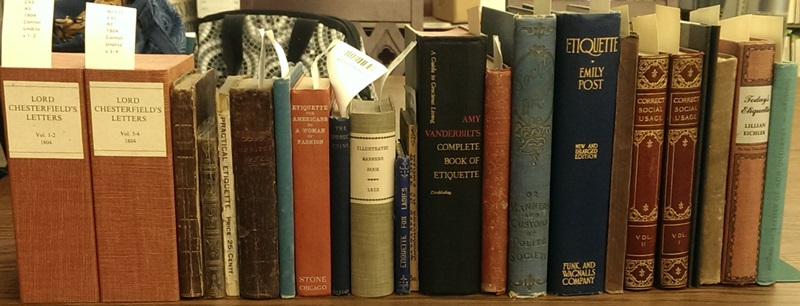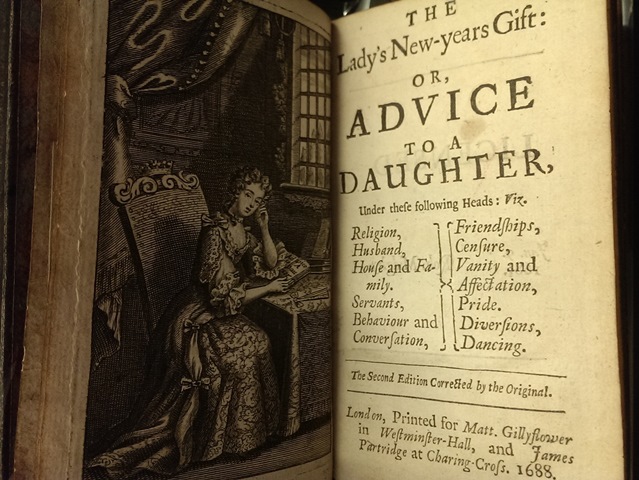 Browsing the shelves on the fifth floor of the University of Tulsa’s Special Collections, I
Browsing the shelves on the fifth floor of the University of Tulsa’s Special Collections, I  found a little 4 ½ inch blue covered book titled True politeness: A hand-book of etiquette for ladies. The author attribution is “by an American lady” and was published in 1847. This small volume contains sixty-four pages of little bits of etiquette advice on fashion, conversation, visiting friends, parties, etc. For example a lady’s gloves should ‘harmonize with her dress and always be clean’ or a lady should ‘never go early to a public ball’ or when playing card games ‘women should never play, unless they can retain the command of their temper’.
found a little 4 ½ inch blue covered book titled True politeness: A hand-book of etiquette for ladies. The author attribution is “by an American lady” and was published in 1847. This small volume contains sixty-four pages of little bits of etiquette advice on fashion, conversation, visiting friends, parties, etc. For example a lady’s gloves should ‘harmonize with her dress and always be clean’ or a lady should ‘never go early to a public ball’ or when playing card games ‘women should never play, unless they can retain the command of their temper’.
Finding this charming little pocket book encouraged me to search for more books about etiquette advice and social customs in the Special Collections. I then discovered many more old volumes detailing proper behaviors for the times in which they were written. The etiquette books in the TU Special Collections range from the late 1600s to the mid-20th century. The oldest book was published in 1688 and titled The Lady’s New-years Gift: or, Advice to a Daughter. This late 17th century work details advice on religion, marriage, house and family, servants, behavior and conversation, friendships, censure, vanity and  affectation, pride, diversions, and dancing. This is a small 5 ½ inch volume with 164 pages. Amy Vanderbilt’s Complete Book of Etiquette: a guide to gracious living is a 700 page tome and was published in 1954. The 20th century book encompasses the details of life ceremonies, dress and manners, home entertaining, household management, correspondence, family and social education of the children, public life, official etiquette for civilians, and travel etiquette at home and abroad.
affectation, pride, diversions, and dancing. This is a small 5 ½ inch volume with 164 pages. Amy Vanderbilt’s Complete Book of Etiquette: a guide to gracious living is a 700 page tome and was published in 1954. The 20th century book encompasses the details of life ceremonies, dress and manners, home entertaining, household management, correspondence, family and social education of the children, public life, official etiquette for civilians, and travel etiquette at home and abroad.
These types of advice books offer a unique view into the lives, values and behaviors of the people and society.1 Of course the earlier works were certainly intended for the upper classes but as literacy increased and books became more widely available, these etiquette books were available to other demographics. For example Emily Post’s and Lilian Eichler’s books on etiquette, published in the 1920s, were less formal and rigid and more democratic in style and expectations.2
Some other etiquette tips:
1688- “Your Servants are in the next place to be considered; and you must remember not to fall into the mistake of thinking, That because they receive Wages, and are so much Inferior to you, therefore they are below your Care to know how to manage them.”
1804- “Uncleanness, which is of all vices the most shameful”
1856- “The first fundamental rule of good taste is to be natural…In manner or style, affectation is the source of the most flagrant offences against taste.”
1888- “It is not the Correct Thing for a gentleman to go in to dinner with a lady, without offering her his arm.”
1907- “The graceful lifting of the hat on all proper occasions is one of the marks of a gentleman.”
1942- “Wartime Entertaining: It is considered bad form to entertain lavishly or expensively in wartime, when money is so urgently needed for other, more important, things. Simplicity should be the keynote of any function planned for men in the armed services.”
1954- “If we know nothing of our neighbor’s beliefs or background we may unwittingly offend him. If we have only a vague idea of his religious customs and taboos we may seem discourteous by out failure to respect them in our contact with him.”
If you are curious as to other interesting tidbits of social customs and deportment, all of these etiquette books are available to be viewed at the Special Collections Monday-Friday 8-5.
References
- http://www.vahistorical.org/collections-and-resources/virginia-history-explorer/advice-and-etiquette-books
2. http://tcs.sagepub.com.ezproxy.lib.ou.edu/content/16/4/25.full.pdf+html
